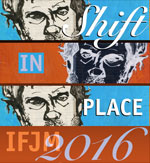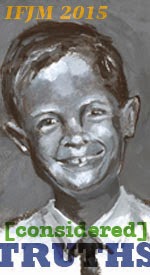Above: Day 26 of my 2014 fake journal, brush pen with rubberstamp ink and acrylic markers (eyeglass frames). 22 x 30 inch sheet of printing paper. Toes left in for scale.
Collaboration can be great for the creative process, but not all
projects lend themselves to collaboration. This is the case with fake journals.
There have been a surprisingly high number or queries this year from
people wanting to make a fake journal in collaboration with another person for
International Fake Journal Month.
While all the ideas suggested have been fabulously creative and
represent projects the artists are passionate about they haven’t been a fit for
IFJM for one simple reason.
A collaborative journal where more than one person pretends to be
the SAME person isn’t a fake journal, it’s a faux journal. As long as there are
multiple people trying to be one person none of the people can completely be the fake person and create a complete fake journaling experience.
To create a fake journal you need to be in character when you create
the journal, and you need to have the daily experience of being in that character’s skin (the character who is creating the journal) on a daily basis.
Those are really the two main criteria for creating a fake journal:
a character, and daily (or as near as daily as you can get) participation, with
“real-time” entries (e.g., if it’s 4 o’clock when you are writing it’s what you
label the entry).
When two or more people attempt to keep a journal by one character,
rotating the days that they work, they separate themselves from one of the best
features of the project—habit building.
Collaborators also put themselves at risk for dealing with another
artist's “issues.” If you have no control over what the other artist does to
your character before it’s your turn again that other artist may take the character
in a totally new direction away from avenues of exploration you might have
benefited from. In a worst case scenario it might also push one of the
collaborating artists into a creative block because he or she is losing
ownership of the character, process, and the progress.
When artists collaborate in this fashion on a faux journal what they
are actively engaged in is a conscious act of fiction. And there is more
distance between the character they create in unison than one they would create
themselves. If one artist doesn’t like something the character is doing she or
he can step back and say, “that’s X’s [the other artist] doing that” and in the
very act of naming that origin of creation the second artist no longer has to
“deal” with the issues presented in a personal way, but can fashion a fictional
and distant response.
In fake journaling, the goal is not to create a fiction with a
beginning, middle, end, moral, etc. The goal is to inhabit a character in a
slice of life. (Such character building exercises can then of course be used to
create background for fictional works and many writers do this, but it isn’t
the prime function of the fake journal—a fake journal that is kept as a
journal: one consciousness, entries dated and timed as they actually happen,
etc.)
The prime function of the fake journal is for an individual to
identify some problem or issue in her (or his—understood from no on because
this is clunky typing both) creative life or artistic approach and make a
conscious decision to address that item by being a character who either doesn’t
have that same issue or by being a character who is immersed in that issue but
is coping with it in some other fashion that the artist would not have considered in her own life.
In other words the fake journal becomes a safe place for the artist
to play art or investigate alternative approaches to what it’s like to live
without the same constraints, freedoms, etc. she faces.
It’s a process which ultimately works best when the artist takes an
inventory of issues, problems, abilities, time constraints and creates a
response to explore in, unfettered by infiltration by outside sources for at
least 15 minutes a day.
Collaboration opens not just a back door, but throws open wide the
front door to outside sources. This can lead to serious issues and problems.
It may be very enticing to set up a collaboration to create a fake
journal but it is impossible. If two people are creating one character all you can ever have is a faux journal.
Also you need to ask yourself, “why am I uncomfortable or unsure about
creating one on my own?” Is the collaboration a way to surround yourself with
support so you don’t have to deal with issues that come up? That defeats the
purpose of the creative process.
Many people who participate in IFJM choose to deal with creative blocks and trouble with an internal critic. If you do that in a faux journal collaboration you lay yourself open to
double levels of abuse when your internal critic comes after you for putting up with the creative choices of your partner, or depending on your partner, or whatever. Life is too short.
You’re simply better off calling it what it is—a creative fictional
writing collaboration. Then you can deal with it with appropriate creative boundaries
and negotiations. And you can keep your private artistic life, your creative
block (and the reasons for them), your desire to work in a new medium as a
beginner, etc. all to yourself—to deal with on another day.
I am a fan of collaboration in art. It has its place. And two
creative minds are often better than one. But in a fake journal where you are
asking yourself to be honest and intimate with your own reactions and practice
and motivations in life it isn’t safe to let another person in. We need that
time alone.
Collaborations that Work Within IFJM and Fake Journaling
I suggested to all the folks writing to me about doing collaborative
projects the following:
1. Each keep a journal with an individual character and have your
characters interact. Then each of you is keeping a fake journal of your own
individual character. What you create between the two of you is interaction and
you each remain in control of your individual character’s reaction.
2. Collaborate with yourself. Keep two fake journals each kept by a
DIFFERENT, individual (and we aren’t talking about finding out at the end of
the month that the two characters were actually split personalities—I really
mean two separate characters). The two characters then interact but you also
have to deal with each one of them individually, keeping within the constraints
of keeping a fake journal (timed entries, one character, etc.).
I’ve done the latter two times, once in the 1990s and in 2001. It is
a hell of a lot of work and I think you are actually better served by focusing
on one character.
When Creating a Faux Journal Is Really What You Want
The people who queried me all had interesting projects and I wished
them all well. If you have a collaborative project
where you both inhabit the same character I urge you to view it for what it
really is, an exercise in creative fiction.
If you want to complete your project within a particular time format
(week, month, year) set up your boundaries and have at it. You’ll benefit from
sharing the creative process with someone you obviously trust and respect (or
you wouldn’t have bothered setting up the project) and there are many benefits,
most obvious of which is daily contact and support, to be derived from such a
partnership.
If you wish to pursue your project under the constraints and
boundaries of a larger group project I urge you to check out the various
Fiction-in-a-Month options that are available online now. There’s a group that
writes a novel in 30 days (November) and I think they also sponsor a screenplay
in a month option in another month. You’ll find groups who write Young Adult
novels in a month, mysteries in a month, and so on.
You will find a fit for your creative fiction project.
Projects with Children
Most children don’t have creativity problems. They just
want to create. As a parent, if you want to collaborate with your children on a
daily creative project I encourage you to create such a project on the fictional model so
that children don’t become self-conscious.
One woman wrote about the prospect of creating a fake journal in
collaboration with her kids. She would be responsible for the writing and they
would illustrate it (or maybe it was the other way around I can’t find that
letter). After I explained that she was creating a faux journal because it
wasn’t coming out of a single consciousness, I encouraged her to simply take a
month in the summer when her kids aren’t in school and set up parameters for a
daily creative project that involves collaborative writing and drawing.
This approach opens up the project to allow them to work for several
hours a day, for instance, on several plot points in the story line, and this
gives them a real taste of creating fictional characters. (But again it has
nothing to do with fake journaling.)
They are also no longer tied to the clock as we are in fake
journaling. If the wave of creativity catches them they could write a “week’s
worth” of entries in an afternoon because it is fictional.
The difference is significant.
I think that by engaging your kinds in a faux journaling/fiction project you
can help them develop narrative skills and creative muscles that they'll be
able to use in all walks of life. That’s always a wonderful outcome.




















